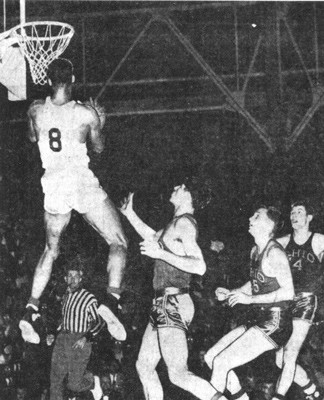Americana: Indiana
04 - 29 Nov 2008

Six-two Bill Garrett rebounding against Ohio State, February 6, 1950. Photo: Frank Fisse, the Indianapolis News. Courtesy the Indianapolis Star and Frank Fisse.
AMERICANA: INDIANA
Double Dribble
4 - 29 November 2008
The state of Indiana is the center of basketball. First organized in 1892 in Cambridge, Massachusetts, basketball was reformed and integrated into YMCAs across the Hoosier state, rapidly spreading to Indiana high schools and universities. By the 1940s, this athletic profusion generated a frenzied statewide obsession with the sport and soon whole towns rallied behind their high school's team with a fervor that was quickly dubbed "Hoosier Hysteria." On certain days of the week dedicated specifically to the sport, stores closed, schools implemented early dismissal, and special ceremonies and celebrations commenced in competing towns.
Basketball in Indiana, however, also harbors a history of racial segregation and discrimination. In the early history of the sport in the state, white players in Catholic high school teams never competed against African American teams. Where mixed race teams did exist, African American players were prohibited from showering with white teammates, were forced to spend nights in hotel basements during away games, and were stripped of the possibility to play on college teams.
African American player Bill Garrett faced such discrimination. On Saturday, March 22, 1947, Garrett's high school team, the Shelbyville Golden Bears, defeated the Terre Haute Garfield team in the Indiana State Championship. Before that year, no winning team in the championships had ever had an African American player and no player had ever been quite as revered and celebrated for his skill and knowledge of the game as Garrett. That same year, Garrett went on to win Indiana's Mr. Basketball Award given to the best high school player. With the help of activist Faburn DeFrantz, Garrett brought on the integration of college basketball after the breakdown of the Big Ten 'Gentleman's Agreement' designed to refuse African Americans. The composure he displayed in the face of the racial tensions that characterised Indiana in the 1940s preserved his legacy in the sports' history. His story serves as the impetus for this exhibition's investigation of an American athletic phenomenon.
The exhibition Double Dribble examines Indiana's unique role in pre-Civil Rights era desegregation. Today, racism still plays a role in basketball as African American players are bound to the sport in such ways that reflect the racist parody implicit in early 20th century minstrelsy; skill is seen as racially determined and not the result of practice and hard work. This exhibition illuminates the sport's stigmas and the underlying consequences for race issues in the US. In subtle ways, the sport of basketball illustrates, in three-pointers and double dribbles, the mistakes of a nation built around both the fear of difference and the fear of defeat.
Curated by Tanner Borskey
Double Dribble
4 - 29 November 2008
The state of Indiana is the center of basketball. First organized in 1892 in Cambridge, Massachusetts, basketball was reformed and integrated into YMCAs across the Hoosier state, rapidly spreading to Indiana high schools and universities. By the 1940s, this athletic profusion generated a frenzied statewide obsession with the sport and soon whole towns rallied behind their high school's team with a fervor that was quickly dubbed "Hoosier Hysteria." On certain days of the week dedicated specifically to the sport, stores closed, schools implemented early dismissal, and special ceremonies and celebrations commenced in competing towns.
Basketball in Indiana, however, also harbors a history of racial segregation and discrimination. In the early history of the sport in the state, white players in Catholic high school teams never competed against African American teams. Where mixed race teams did exist, African American players were prohibited from showering with white teammates, were forced to spend nights in hotel basements during away games, and were stripped of the possibility to play on college teams.
African American player Bill Garrett faced such discrimination. On Saturday, March 22, 1947, Garrett's high school team, the Shelbyville Golden Bears, defeated the Terre Haute Garfield team in the Indiana State Championship. Before that year, no winning team in the championships had ever had an African American player and no player had ever been quite as revered and celebrated for his skill and knowledge of the game as Garrett. That same year, Garrett went on to win Indiana's Mr. Basketball Award given to the best high school player. With the help of activist Faburn DeFrantz, Garrett brought on the integration of college basketball after the breakdown of the Big Ten 'Gentleman's Agreement' designed to refuse African Americans. The composure he displayed in the face of the racial tensions that characterised Indiana in the 1940s preserved his legacy in the sports' history. His story serves as the impetus for this exhibition's investigation of an American athletic phenomenon.
The exhibition Double Dribble examines Indiana's unique role in pre-Civil Rights era desegregation. Today, racism still plays a role in basketball as African American players are bound to the sport in such ways that reflect the racist parody implicit in early 20th century minstrelsy; skill is seen as racially determined and not the result of practice and hard work. This exhibition illuminates the sport's stigmas and the underlying consequences for race issues in the US. In subtle ways, the sport of basketball illustrates, in three-pointers and double dribbles, the mistakes of a nation built around both the fear of difference and the fear of defeat.
Curated by Tanner Borskey
